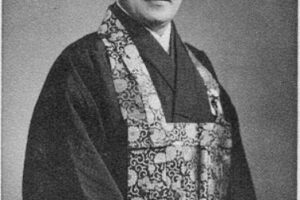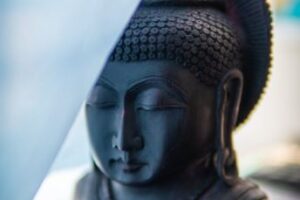
In Zen circles, we often hear the teaching that we should suspend judgment — especially in meditation, regarding ourselves as well as others — so often that it has become a cliché. This admonition is also referenced in Soto Zen Precepts received during ceremonies, such as “Do not discuss the faults of others,” and “Do not praise yourself at the expense of others.”
These two are included in the second five of the Ten Grave Precepts of Buddhas and Bodhisattvas, which Matsuoka Roshi reserved for formal stages of priest training (Zaike and Shukke Tokudo), being more socially oriented, i.e. regarding transactions with others, than the first five of Initiation (Jukai), as is to be expected for those wishing to be trained in training others. But I think the more personal and direct application of the act of judging is probably best for understanding the vital functioning of Precepts, especially in zazen; but also in relationships to others.
If we substitute the word interpretation for judging, we can develop a tighter focus on our direct experience of the way the mind typically works, the so-called monkey-mind of discriminating thinking. Discrimination has continued to carry negative connotations in our ostensibly post-racial society, but at heart the ability to discriminate is just that. It is neutral, like any other tool or capability. Whether it is positive or negative in effect is a matter of how we use it; but of course, such a thumbs-up-or-down evaluation is also a judgment call. We cannot escape this aspect of mind. But we do not have to be driven by it.
Moving from the “outer” realm of making judgments about others, and various situations we encounter, to the “inner” realm of those we make about ourselves from time to time — or if we are hyper-critical, constantly — let’s consider how this may manifest during zazen itself.
The Zen model of the mind is based on Buddhism’s teachings of the Five Aggregates (S. skandhas) and Six Sense Realms (S. dhatus) — the former parsing holistic experience into various categories of sensory awareness, built into the subjective mind; the latter those relevant dimensions of the mind’s sense objects — expanding the dynamic of sentience into a complex, and fairily comprehensive, model. Modern science has not substantially contradicted or simplified this model, but further extended it into the microcosmic realm of neural networks and chemical exchanges on the nervous system and the brain; as well as dissecting the sense organs in great detail, and illuminating the operations of the brain through real-time imaging.
Nonetheless, all this information about the way our information-processing proceeds still does not address the “so what?” question: How, then, does this trigger my own, personal insight? Nor does it answer the challenge of what to do about it, when we come up against the same old, same old, knee-jerk reactions to causes and conditions arising in our meditation, and impinging upon our daily life.
Most of our practice can be said to depend upon observation, in the scientific sense, but without pretense to absolute objectivity: Zen includes, importantly, most centrally, the observer. Zazen — our stripped-down, high-performance engine of a meditation — provides the vehicle, but does not automatically get rid of the driver. In fact, sitting “until you forget that there is someone sitting,” Matsuoka’s turning phrase (J. wato) demarks a turning-point in our training, not a condition or assumption going in. This is captured in Master Dogen’s “To study the Way is to study the self… to forget the self” and many other Ancestors’ teachings.
One of the key symptoms of the continuing operation of the controlling self is this tendency to judge anything and everything that comes into its awareness. Sometimes it does so neutrally, usually with some passion, or self-righteous brio, and even a good helping of animus. But if we examine the model of the process offered by Zen Buddhism, we can find those weak points at which we may be able to insert the lever of analysis, to subdue and subvert the monkey’s auto-pilot discriminating. To quote one of our Ch’an Ancestors, Master Sengcan:
The burdensome practice of judging brings annoyance and weariness.
For example, in contemplating “bare awareness,” a common description of a phase of meditative attention that sometimes surprises newcomers — but eventually comes to be familiar to long-time meditators — we begin to witness the breakdown of the seemingly seamless nature of the flow of information from the senses to the brain and back, the standard Western model of sensory awareness, including its accompanying emotional triggers and reactions. Rather than picking up the thread somewhere down the line — where we find ourselves already immersed in disgruntled, even angry, internal dialog, about this or that aspect of what is happening in the moment; or what happened a few minutes ago, or even yesterday; or, for that matter, what may yet happen today or tomorrow — we find ourselves getting ahead of the train a bit. Or lagging behind it, if you will. In any event, we are no longer simply riding the train.
We notice the slightest change of stimulus, say in the form of air movement caused by the ceiling fan; a subtle shift of light level; or a sudden relative quiet, when the air conditioning cuts off. Just a simple acknowledgment of a slight change in ambience, no big deal. But we may also recognize that our reaction to it is neither positive or negative, just neutral. Staying there for a moment, we find our attention fixated in our senses, rather than in follow-up, judging thoughts, as such. At the next moment, another subtle change may catch our focus.
If we pay really close attention, we begin to move to a plane of awareness that approaches simple registering of sensation, moment by moment, the slightest shift from one degree to another. In doing so, the so-called “inner and outer” dimensions of sensation itself begin to fuzz out, into a boundary area of overlapping outer stimulus, and inner responsiveness. This can be a delightful discovery. Or more like a long-forgotten, primordial memory.
As awareness expands to include all sensation simultaneously — eye, ear, nose, tongue, body and mind — the kaleidoscopic, kinetic activity transpiring both in the environment and in our body-mind becomes evident, emerging as a polyrhythmic, polychromatic and polytonal parade of passing pageantry, so to say. But if we insist on interpreting each and every little mote of stimulus that comes our way, we disrupt the flow, and the harmony, of our little program.
If, for example, we are not satisfied with simply registering a thought about what we feel in the immediate present, or how we feel about something someone did in the proximate past, we have no other choice than to interpret both: how we feel, and what they did. It is in the compulsion to interpret the raw data that we run into trouble. On his formative trip to India, Baba Ram Dass says he met a young American, whose guru he finally also met. When Ram Dass would mention a feeling he had, this expatriate would say, “Feelings are like waves on the ocean; watch them disappear on the horizon.” (This was part of a long talk Richard Alpert, the well-known former advocate of LSD gave to my students at the U of I in Chicago, in the 1960s.) All too often, however, we do the opposite. We nurture, and obsess over, our feelings. In zazen, we find we can let them dissipate, if not disappear altogether.
In professional research, we concern ourselves with findings, conclusions and recommendations. In designing a study, whether conducted in focus groups, with individuals, or through participant observation (so-called ethnographic studies) the apprpachapproach is to let the information flow to us, without biasing it. The interviewer, or moderator, works like a mirror, to simply reflect, and encourage, the dialog, rather than directing it. Similarly, when practicing “opening the hand of thought,” as Uchiyama Roshi phrased it, or the “backward step” of Master Dogen, in zazen, we let the information flow to us, without interpreting it. This would be the findings phase.
But in preparing the reports for the client, one has to draw relevant conclusions from the findings. (Some ersatz research firms actually do not, but simply dump the findings on the client, leaving them to sort out their own conclusions.) In any case, someone has to translate the raw findings into meaningful data, information upon which action can be taken. My senior partner and mentor would often say that you have to finally “Take your guts in hand, and tell them what it all means.” In other words, you must interpret! That is what they pay you for.
Now, when it comes to interpreting the most intimate, personal information to which we have access, the kind that becomes apparent in Zen meditation, we come up against what Thoreau expressed as a kind of conundrum, wrapped in an enigma, on the horns of a dilemma:
The mass of men lead lives of quiet desperation.
To be socially correct, and sensitive to gender bias, today we would add that the mass of women probably do so as well, if only because most of the men in their lives are desperados. But stepping out of the social context for the sake of simplicity, if we look at our zazen as an act of quiet desperation, we might come closer to the worldview of Shakyamuni Buddha and the Ancestors. We sit in meditation, admitting to ourselves, at least, that we do not know what we fundamentally most need to know. And unless we have gotten to the point of desperation about it, and are willing to exercise a bit of faith that Zen may offer a final resolution, our zazen is probably not the real thing, the “real zazen,” as Matsuoka Roshi referred to it.
The other sign that our zazen is not yet complete, not the real deal, is if we are constantly interpreting it. That is, interpreting the raw sense impressions through the filter of preferences. The Ch’an quote above comes from “Trust in Mind,” the first line of which is:
The Great Way is not difficult for those who have no preferences.
Here, we do not believe the great sage is suggesting that we seriously examine, and perhaps forgo, our preference for chocolate ice cream over vanilla. Later in the poem, he says, “So too with being and non-being.” So we are not playing around here. We assume our practice to be about life and death, in a very direct way. We examine closely our desire for life, and our fear of death. Not in a morbid way, but as a very practical consideration. Unless we are a true believer, we do not know of any examples of any living being that escaped death, ultimately. If we look closely, we may find that we are actually interpreting our lives, rather than living them. But Zen is about being truly alive. Which finds meaning only in the context of death.
On a less fraught plane, we can examine our proclivity to interpret the behavior of others. For example, when a member of the sangha goes missing for several years, we tend to interpret that event. We may assume, or speculate, that they are just not as serious about Zen as we are. Matsuoka Roshi would occasionally respond, when I would ask him about so-and-so, “Come-and-go type.” Or, “Wishy-washy type.” These two phrases may represent a finer parsing, or interpretation, of someone’s character. Wishy-washy is a bit more harsh than come-and-go. But remember, O-Sensei was working with tropes from a second language, not native to him.
Later on, the missing person may one day reappear on the doorstep of the Zen Center, a bit more gray and the worse for wear, perhaps. And as their story unfolds, it seems that owing to circumstances beyond their control, they have been unable to be present for practice in this particular location and during this particular period, for good reasons, no excuses. And had they been able to, they would have preferred to have been in attendance. The native Americans have a saying I recall from high school studies, that we should “Walk a mile in their moccasins” if we are prone to judge someone we do not know very well. Another platitude admonishes us not to assume someone hasn’t changed if we have not seen them for over a minute.
Even less personal, but fraught with broad and deep meaning, are the events that impinge upon us from the world at large, and nature in general. These include the political, business, and other spheres, where human nature often seems not worth interpreting, even if we had the ability to do so. But on an even larger scale, we in certain parts of the United States recently had an opportunity to engage in a transcendent exercise: seeing, and interpreting, the eclipse.
How are we to “interpret” something like a total solar eclipse? Some might argue that it is proof positive of the existence of God, a kind of cosmic signal, or “joke”: that the likelihood of the moon being exactly 1/400th the size of the sun, yet positioned exactly 400 times closer, is beyond any possibility of being a chance occurrence. It is so precise, and so precisely attuned to the perception of human beings (notwithstanding those placing safety glasses on their pets), that it must be intentionally staged to get our attention. That would be one interpretation.
Another would be that, no — that is just the way the forces of nature have choreographed the dizzying dance of the local celestial bodies. And it just happens that humankind has developed the awareness, intelligence, and technology to appreciate it. There was a time when knowing a solar eclipse was about to occur amounted to a very powerful piece of information, accessible only to the inner circle. Nowadays everyone knows way too much about the occurrence. One such eclipse was used to verify the “lensing” phenomenon, a claim made by Einstein that massive bodies will bend light. So there is no basic problem with interpretation itself. Again, just a useful tool, for trivial, or transcendent, usage.
But bringing us back down to Earth, interpretation is the first step toward making a judgment. If we can catch ourselves in the micro-moment — before the act of interpretation has a chance to set in place — we can avoid the more insidious aspects of the judgmental mind. Then the Mind that has no preferences, Bodhi-mind, can come to the fore.








